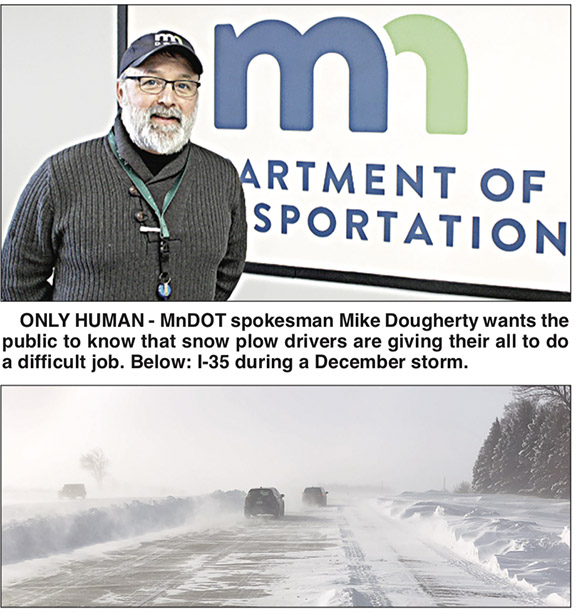Drivers asked to adjust to conditions
By DEB BENTLY
Staff writer
 Mike Dougherty recognizes that it’s frustrating to have to slow down in bad weather conditions. But he points out that it’s even more frustrating to end up in the ditch. “You’ll get there faster driving safely,” he says.
Mike Dougherty recognizes that it’s frustrating to have to slow down in bad weather conditions. But he points out that it’s even more frustrating to end up in the ditch. “You’ll get there faster driving safely,” he says.
A spokesman for the Minnesota Department of Transportation (MnDOT), Dougherty’s territory covers the 11-county region in the southeast corner of the state, from the Wisconsin border to Freeborn County, and just north of Minnesota Highway 19 at Northfield.
In a recent conversation dealing with travel safety, and specifically with safety around snow plows, Dougherty observed that plow drivers are human, too. “They get into this because they want to help,” he says. “They take that responsibility personally.
“We put them out in some of the most difficult conditions you can imagine–in the dark, in blowing snow, on ice and in sub-zero conditions.
“It’s disheartening when people express anger at them.
“We don’t have a magic wand that can fix things. It takes good, old-fashioned time and effort.”
Dougherty has three strong recommendations when it comes to safety around working snow plows.
Slow down: Adjust speed to the circumstances.
Leave room: Recommended distance is 10 car lengths.
Stay vigilant: Let phone calls or adjustments to music wait.
Dougherty says that, as one who works with crews across 11 counties, he is always impressed by the dedication and fortitude he sees. “These folks have your best interests at heart,” he says. “You can respond to that by keeping yourself safe.”
The first step, in times of bad weather, is making an informed decision about whether to be on the road at all. Dougherty mentions that MnDOT has a number of services to help with the task. Both a website and an app are available at 511.MN.org. Information is kept current there regarding developing road conditions, including road closures. There is also access to live cameras broadcasting images from snow plows and from locations along many state highways. People can also follow along on social media with Twitter (www.twitter.com/mndotsoutheast) and a Facebook group (https://www.facebook.com/groups/MnDOTsoutheast) to get updates and information.
For those who decide to travel, Dougherty suggests having proper emergency equipment, including a shovel and tools for those who become stuck, and cold weather gear to stay comfortable and safe in case of being stranded.
If an emergency situation should develop, Dougherty suggests remembering the “big picture.” It’s not only a matter, for example, of getting one’s own car out of a ditch, but doing so without causing further harm–perhaps by stepping too close to traffic lanes. He points out that, if one car has hit a slippery patch and slid off the road, another one might hit the same patch. “People are safest inside their vehicles, wearing their safety belts,” he observes, especially since cell phones make it possible to call for assistance without ever getting out. Even for those whose cell phones might be out of commission, stranded motorists can feel assured their welfare is being looked out for. Snow plow drivers frequently stop to check on vehicles, or at least notify law enforcement of the circumstances.
Incidents along highways can have a whole “ripple effect,” which affects the safety of, potentially, hundreds of people, from other drivers to emergency response personnel, Dougherty observes. “Don’t let the distractions of the moment keep you from truly considering your circumstances.”
Regarding incidents along highways, he says, law enforcement officers and snow plow drivers acquire quite an array of experiences. Dougherty tells of a plow driver who, during the storm which began on Dec. 22, suddenly noticed a pedestrian walking along the highway shoulder he was in the process of clearing.
The woman had been in a disagreement and exited a vehicle. Since her phone happened to be dead, she saw little choice but to begin walking toward the nearest exit. But at 4:30 in the morning and in bad weather conditions, she was barely visible.
“The driver was quite shaken up about what could have happened,” Dougherty observes. “Fortunately, he saw her and was able to stop in time.”
The driver then gave the woman a ride to the nearest convenience store where she was able to warm up, charge her phone, and call for a ride.
“They’re called ‘safety personnel’ for a reason,” declares Dougherty. “They have your best interests in mind and are out there to serve you.
“Please respond by making choices which keep you–and the people around you–safe.”
In the meantime, MnDOT is persistently looking for ways to improve safety. For example, the flashing amber and blue colors used for snow plow lights has been shown to have the best visibility in poor conditions such as blowing snow. “We’re a learning organization,” says Doughterty. “We certainly ‘respond’ to problems, but we also work to prevent them in the future.”